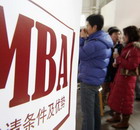Top Biz News
Export engine warms up, time needed for recovery, upgrading
(Xinhua)
Updated: 2009-12-14 17:17
Although some Chinese exporters have seen a fledgling market recovery, they should prepare for a long-term struggle as trade pressure grows, says Wu Tiejun, assistant mayor of Qingdao city, one of China's export powerhouses.
"Chinese export enterprises are facing growing trade frictions and expectations of a yuan appreciation," Wu says.
Chinese products with a total value exceeding $11.68 billion have been subject of 101 trade remedy investigations launched by 19 countries and regions in the year till Nov 3, said Assistant Commerce Minister Wang Chao on Dec 3 without giving comparative figures.
Exports continued to drop in November by 1.2 percent from a year earlier, showing a full-fledged export recovery was still elusive.
Wu says rising commodities and labor costs have also eaten into some exporters' slim profit margins.
"The annual exports of our company reached $100 million in good years before the financial crisis. Our export volume has risen 15 percent from a year earlier, but the export value contracted to less than $70 million," says Huang Bao'an, executive vice president of Qingdao-based China Kingking Group, a craftwork candles exporter.
Chinese exporters previously had a low-cost advantage, but this is being diminished by raw materials and labor cost spikes, Huang says.
Wu Yongwei, a sock manufacturer manager in Datang Town of Zhuji city, eastern Zhejiang province, who says orders fell 10 percent in 2008 from 2007 and began to stabilize and grow in September.
Datang has become the center of a specialist sock-making industrial district in Zhuji, producing 1 in every 3 pairs of socks worn in the world.
"Our combined exports volume had risen 30 percent year-on-year by October, but our profitability ratio shrank to about 5 percent from 10 percent prior to the financial crisis," Wu says.
Reduced profitability is a problem facing other sock makers in the town. The average export price of per pair of socks produced in Zhuji dropped to $0.297 this year from $0.378 last year, a decrease of 21.4 percent.
"It is unlikely that we will ever return to the old way of doing things. China's foreign trade will recover as the recession ends, but people in developed countries will not for a time go back to their own patterns of buyings," says Dr Robert Lawrence Kuhn, an international investment banker and senior adviser at Citigroup.
"The US need to rebuild savings means that a strategy that requires strong US consumption growth may be flawed. These are all reasons to think that China may decide to pursue a less export-intensive growth strategy in the medium to long-term," says Kevin Harris, the US-based chief economist of the Informa Global Markets.
The challenge for China is to increase the value-added elements of products, primarily through technology and branding. Only this will enable companies to pay higher wages to workers, whose buying power will stimulate and sustain the economy, Kuhn says.
More efforts would be made to promote the economic development pattern transformation and improve the quality and added value of exports next year, said participants at China's Central Economic Work Conference last week, setting the tone for the nation's economic development in 2010.
"Chinese firms need to wean themselves away from relying on low cost and homogeneous products competition," says Xu Zhihua, executive director of eastern Fujian-based Peak Sport Products Co Ltd, whose sport shoes have entered the US market at more than $50 per pair.
"This is not an easy task. If we can make it, we can survive the downturn and change the low-end image of 'Made In China'," Xu says.













